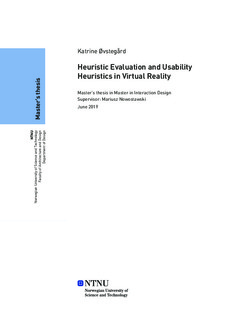| dc.contributor.advisor | Nowostawski, Mariusz | |
| dc.contributor.author | Øvstegård, Katrine | |
| dc.date.accessioned | 2019-09-19T14:00:15Z | |
| dc.date.available | 2019-09-19T14:00:15Z | |
| dc.date.issued | 2019 | |
| dc.identifier.uri | http://hdl.handle.net/11250/2617722 | |
| dc.description.abstract | Med stadige forbedringer i teknologi og maskinvare har Virtual Reality (VR) oppnådd en
fornyet interesse og stadig flere VR-applikasjoner blir designet og utviklet for ulike
bransjer og formål. Bransjer som har sett den potensielle verdien av VR er blant andre
underholdningsindustrien, og mer spesifikt spillindustrien som tilbyr et økende antall spill
for VR. Helsesektoren har også funnet teknologien nyttig til blant annet
smertebehandling og behandling av fobier. Arkitekt-, ingeniør- og anleggsbransjen har
tatt i bruk VR til ulike formål, som for eksempel til å bedre samarbeid,
designgjennomganger, samt for å kunne involvere sluttbrukeren i større grad.
Denne fornyede interessen og det økende antallet VR-applikasjoner, har også ført
til en økt innsats for å forbedre brukervennligheten. Mye av dette arbeidet omhandler
forbedringer av teknologiske aspekter, og det er flere indikasjoner på at det fortsatt er
betydelige bruksproblemer med flere VR-brukergrensesnitt. Denne studien søker å
utforske hva årsaken til dette kan være, om det er forårsaket av mediet og dets
utfordringer, eller om det kan være ha sammenheng med designprosessen.
Gjennom denne studien søker forskeren å utforske designprosessen til utøverne
som jobber med design og utvikling av VR-applikasjoner. Videre søker den å undersøke
om metoder fra 2D-HCI kan benyttes i designprosessen.
Resultatene fra studien tyder på at metoder og prosesser fra 2D-HCI, som
heuristisk evaluering og heuristikk, kan benyttes til design og utvikling av VRapplikasjoner,
dog med noe tilpasning. Videre viste studien viste at de fleste utøverne
ikke er kjent med heuristikk og heuristisk evaluering. Studien finner også at de fleste
industriutøverne bruker det som kan ses på som en prosess tilsvarende en
brukersentrert designprosess, inkludert et tidlig fokus på brukere, en iterativ prosess og
bruk av empiriske målinger (Gould and Lewis, 1985). | |
| dc.description.abstract | Virtual Reality (VR) have recently received a renewed interest with improvements in
technology and hardware, and there is an increasing number of VR-applications being
designed and developed for various purposes. Industries utilizing this new opportunities
are among others the entertainment industry, and more notably the gaming industry,
offering an increasing number of VR games. The health sector have also found the
technology useful in several areas such as pain management and treatment of phobias.
The Architecture, Engineering and Construction (AEC) industry have utilized VR for
various purposes such as improving collaboration, design reviews as well as increasing
end-user involvement.
This renewed interest and increasing number of VR-applications have also lead to
efforts towards improving the usability of VR. However, much of these efforts are
concerned with technological aspects, and there are some indications that there are still
significant issues concerning the usability of many Virtual Reality User Interfaces
(VRUIs). This study seeks to explore why this might be, if it is caused by the medium
and its challenges or if it might be caused by the methods used in the design process.
Through this study, the researcher seeks to explore the design process of industry
practitioners working with design and development of VR-applications. Further it seeks to
investigate whether methods from 2D-HCI can be successfully utilized in their process.
The findings from the study suggest that 2D-HCI methods and processes, such as
heuristic evaluation and heuristics, can be adapted for design and development of VRapplications,
although with some customization. The study found that most practitioners
were not familiar with heuristics and heuristic evaluation. Further the study finds that
most industry practitioners utilize what can be seen as a process similar to a UCD-process
which commonly includes an early focus on users and tasks, and iterative
process and empirical measurement (Gould and Lewis, 1985). | |
| dc.language | eng | |
| dc.publisher | NTNU | |
| dc.title | Heuristic Evaluation and Usability Heuristics in Virtual Reality | |
| dc.type | Master thesis | |
